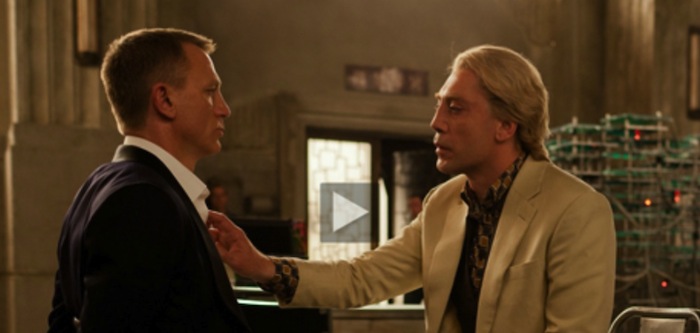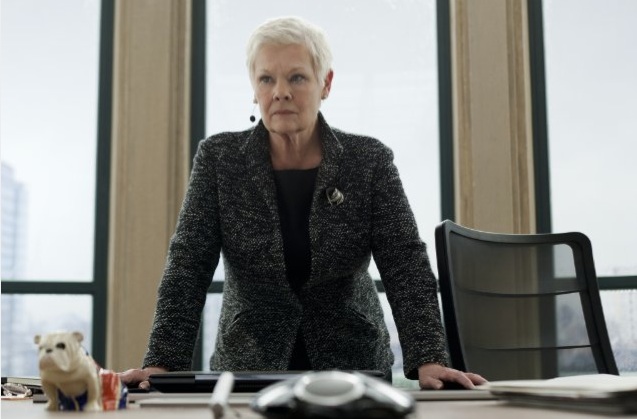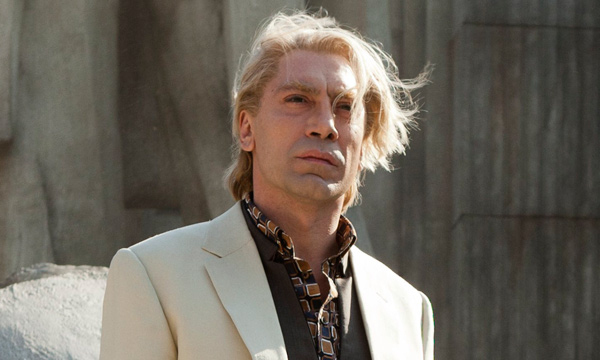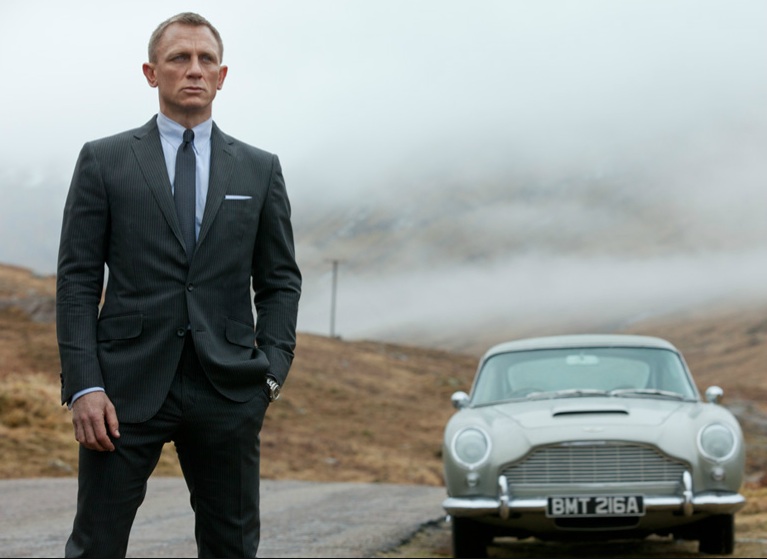
James Bond celebrated his 50th anniversary on the silver screen last year. Dr. No
hit theaters in 1962, based on the 1958 Ian Fleming novel of the same name (sixth in the Bond series). It made Sean Connery a star, launched a slate of films that would position Bond as a global icon for generations to come, and kicked off a spate of imitators capitalizing on the spy craze — some of which, like Mission: Impossible
and Get Smart, became icons of a certain size in their own right.
Was Skyfall, now out on home video, a worthy way to commemorate Bond’s golden jubilee?

I think so, yes. Mostly. $1.1 billion in worldwide box office — the best gross ever for a Bond film by far — says audiences sure liked it; critics did too.
The 23rd entry in Eon Productions’ line of Bond movies, directed by Sam Mendes and once again starring Daniel Craig as 007, was certainly a step up from 2008’s Quantum of Solace. I’m still working through whether I found Skyfall to be more than the sum of its uneven parts or just liked some of those parts enough that the others are merely disappointing rather than deal-breaking.
My introduction to the franchise at 8 years old was Moonraker, 1979’s embrace of the sci-fi boom wrought by Star Wars. Roger Moore’s tongue-in-cheek, gadget-laden Bond will always have a place in my heart purely by the Law of First Exposure. I took in early Sean Connery installments on cable soon after, however, and in my adult years I’ve come to regard the men who were Bond as most do: Connery is the yardstick by which all are measured. George Lazenby wasn’t nearly as bad as legend once had it, although he did have the misfortune to be the first Bond in the familiar series who wasn’t Sean Connery. Moore rode the series into utter ridiculousness, but if you were a kid in the ’70s and/or simply have an appreciation for camp, he’s still a definitive Bond. The less said about Timothy Dalton, the better. Pierce Brosnan was a welcome take on the sly, suave Moore model for the ’90s with a bit of Connery’s machismo mixed in. Craig is one well-rounded hunk of stoic spy perfect for today.

I clearly remember the excitement of watching Craig’s debut as Bond, 2006’s Casino Royale, unspool in the theater. Fans were just happy to have 007 back after another of the franchise’s periodic lulls — the result of legal or financial complications if not both. It was a bonus if the new Bond didn’t flat-out suck, and of course Royale kicked ass.
Casino Royale was Fleming’s first Bond novel, published in April 1953. The next year
it was adapted for CBS’s TV anthology Climax! (a title that the 007 of the later films would have appreciated) with Bond as an American agent. In 1967 Columbia Pictures released a feature film based on the novel, the result of a license acquired in 1955, spoofing 007 and starring David Niven. Not until Martin Campbell’s 2006 version was Casino Royale finally adapted for the long-running Eon series begun in 1962 with Dr. No, shepherded by Albert R. Broccoli and Harry Salzman.
One of the most intriguing aspects of Royale was that it — to use an in-vogue and frequently misused term — “rebooted” the franchise, at least after a fashion. Judi Dench continued in the role of M, head of Great Britain’s Secret Intelligence Service, from the Pierce Brosnan films, yet Royale was presented as not only Daniel Craig’s first outing as James Bond but James Bond’s first outing as 007. And that’s where things get rather interesting. [It’s also where this post gets spoilery, particularly in regards to Skyfall. You shouldn’t read any further if you haven’t seen it but plan to.]

I don’t consider myself more than a casual Bond fan, but (thanks either to a childhood steeped in superhero comics or to a natural inclination) I’m definitely a fan of both the intricacies of fictional universes, continuities, mythologies — call them what you will — and reworkings of same, whether intentionally through adaptations in other media or scorched-earth relaunches or simply over time through slow redefinition. With five actors before Craig playing Bond in the official Eon franchise and Desmond Llewelyn serving as Q for all of them, it was easy to think of James Bond as a title that went with the 007 designation, one held by different men — not unlike Q, the Quartermaster, or boss-man/boss-lady M.

At certain points, too, dialogue in the series winks at the cast turnover and changing times. Brosnan’s final film as Bond, 2002’s Die Another Day, was the 20th Eon Bond movie and released during Dr. No’s 40th anniversary; it homaged every previous entry in the series — from a glimpse of the Thunderball jet pack and other past gadgets in
Q’s armory to Halle Berry’s character Jinx recreating Ursula Andress’ emergence from the ocean in a bikini as Honey Ryder in Dr. No — and even showed 007 with a copy of
a book written by real-life ornithologist James Bond, from whom Fleming took his hero’s name.
On the other hand, although 1969’s On Her Majesty’s Secret Service was itself full of references to previous films (and found Lazenby famously lamenting, through the fourth wall, “This never happened to the other fellow...”), its 1963 source novel — the first written by Fleming after the Eon series began production — was the most humanizing look at Bond to date. He visits the gravesite of Casino Royale’s Vesper Lynd, composes a letter of resignation from MI6, and marries a woman (for love, not for a mission) only to lose her. He also muses on a potential relation to 17th-century baronet Sir Thomas Bond.
Which brings us back to Skyfall, at last, on a number of counts.

I was surprised by how much of an outright sequel 2008’s Quantum of Solace was to 2006’s Casino Royale — as opposed to just being the next movie starring Craig as Bond. The series has had callbacks to previous installments, sure, but I believe that Quantum was the first Bond movie to include flashbacks to an earlier film via archive footage. While Skyfall doesn’t follow Quantum as directly as Quantum did Royale, more time having passed between the stories, it certainly seems to conclude a trilogy that taken as a whole provides an extended “origin” for James Bond and his trappings as we’ve come to know them.
Skyfall, written by Neal Purvis, Robert Wade, and John Logan, gives us our first meeting between Craig’s Bond and Ben Whishaw’s Q. Bond’s old family homestead is destroyed. The last cast member carried over from pre-Craig entries in the Eon oeuvre is written out as Dench’s M dies, replaced by Ralph Fiennes. We see Moneypenny assume her role as M’s secretary after spending time as a field agent alongside 007.
Apropos of its title, Skyfall finds Bond and later all of MI6 laid low both literally and metaphorically. In the prologue Bond falls into a river from a speeding train after being accidentally shot by Moneypenny, played nicely by Naomie Harris and identified only as Eve until the end of the film — in a reveal that surprised me in more than one way,
as I’d avoided leaks but also hadn’t really noticed that Moneypenny doesn’t appear in Casino and Quantum. Bond resurfaces after time away, presumed dead, to aid M in tracking down the source of assaults on SIS being conducted by somebody who knows the system intimately. Following the destruction of its offices in South London, MI6 relocates to backup headquarters underground.

Skyfall humanizes Bond much in the same way Royale and On Her Majesty’s Secret Service did — by acknowledging that he has, pardon the phrase, bonded with a select few people and hitting him where it hurts. The destruction of the Bond estate and the death of the one M he’s ever known, one to whom he’s grown increasingly close, maintain the Craig trilogy’s pattern of providing losses that prompt Bond to wall himself off emotionally. Perhaps to cement the grounding of Craig’s 007 in a realistic world (even as his new Q is finally introduced) we’re shown that this incarnation is a man born James Bond; the obituary that M writes for him, the mention of his parents, and that it’s the name by which Kincade, the gamekeeper at Skyfall, knows him all render this incontrovertible fact.
What then are we to make of the Goldfinger Aston Martin DB5 with ejector seats in his storage unit? Why does the mention of Skyfall at his MI6 psychological evaluation set him off? Neither question has a good answer, but only the latter really needs one. The slight metatextuality of the first is intentionally, playfully confounding. The fabricated drama of the second is galling, nonsensical slight-of-hand. Unlike the villain of the piece, Javier Bardem’s Raoul Silva, who makes it clear that MI6 took his very identity from him and begs to hear M speak his true name, 007 is established to honestly be James Bond and so there’s no apparent reason why the Scottish homestead where he grew up should be a mysterious, Rosebud-like trigger.

I know that flamboyant antagonists are a Bond staple, but Silva just doesn’t work for me — not in the milieu of Craig’s Bond, not as played so over-the-top by Bardem. While his flirtatious interrogation of a captive 007 provides Craig with one of the film’s biggest laugh lines, both Silva’s character itself and most aspects of the plot involving him were my biggest peeves with Skyfall. Bond waits until a woman is shot to death by Silva before he acts to get out of a situation. Silva is way too able to carry out cyberattacks on an intelligence network that has to be prepared for such things, which might be more easily swallowed if he weren’t such a cartoon. Nobody thinks to check Silva’s mouth — there’s a joke about cavity searches in there somewhere — before imprisoning him in the heart of MI6’s headquarters where he can jettison the Hulk and take down the entire SHIELD Helicarrier.
Skyfall’s title sequence, created by series veteran Daniel Kleinman, launches from Bond’s drop into the river — echoing, I realize as I write this, Vesper’s death in Casino Royale. The sequence is visually engaging, as award-worthy as the wonderfully throwback theme song co-written and sung by Adele to which it’s set — a song up for
an Oscar next weekend alongside Thomas Newman’s score, the film’s sound mixing and sound editing, and Roger Deakins’ ace cinematography. I was especially happy to be drawn in by the title sequence after the movie’s opening action left me somewhat cold despite real tension and at least one classic Bond moment on the train.
Part of the problem was definitely that I sat in the theater’s last row and had to deal with more distractions in the audience than usual — chitchat and lit smartphones and, no lie, rather loud snoring right in front of me — but as Skyfall got underway I felt like I was appreciating the craft of the action more than I was really being drawn into it. Motorcycles and rooftop chases had been done by the Bourne series as recently as The Bourne Legacy a couple of months earlier, and despite Legacy ranking beneath its predecessors my detachment during Skyfall’s prologue led me to wonder — for all that Casino Royale’s back-to-basics approach was at least in part a (very successful) reaction to modern secret-agent films like Matt Damon’s Bourne franchise — if Bond was still able to compete. Skyfall did The Bourne Legacy one better by serving up motorcycles on rooftops, true, yet I couldn’t help thinking that a certain freneticism that I’d been conditioned to expect, for good or ill, was lacking.

Of course where the 007 series distinguishes itself, where most franchises in fact distinguish themselves, is character. If you strip away almost all the accoutrements, as Casino Royale proved, Bond is still Bond — even as reserved a Bond as Craig’s. Riffs and ripoffs are rife in popular fiction, and they have their place: A thinly veiled take on Superman is able to explore extremes and edges that an actual Superman story can’t, often to intriguing ends. It loses a certain power by not truly being a Superman story, however. You can spoof or clone Bond or Batman or Buffy, you can monkey with their metrics to come up with something fascinating at a tangent, but there’s a particular frisson that only comes from seeing a familiar legend revisited.
Skyfall was perhaps ultimately as enjoyable as it was, in spite of its problems, specifically because it was a James Bond film. And that’s okay with me.
007 logo ® Danjaq LLC & United Artists Corp. Set photos: Francois Duhamel.
Images © 2012 Danjaq LLC, United Artists Corp., & Columbia Pictures Industries Inc.
Related: El on Earth • Identity Crisis • 7 for 007
• What’s Future Is Prologue • Exit from Eden

Nice retrospective of the movie and the franchise.
ReplyDeleteI liked what seems to foreshadow an ensemble series shaping up, with the series regulars taking more of an active role in the future. Both the new M and Moneypenny have field experience and the new Q can fill the computer and information role back at the office.
No more lone wolf.
I'm with you on how confounding the Bond continuity is — one assumes, intentionally.
ReplyDeleteAs you know, I have the same generational references too. Pierce Brosnan was indeed a kind of Roger Moore revisited, and while I don't want to see any invisible cars zooming around I wouldn't mind a modern-day take on some of the cool gadgetry of yesteryear. I got weirded out during the prologue of Skyfall by Bond, Eve, and M communicating through earpieces because the Daniel Craig era has been, like you say, so comparatively real-world, until I realized that the technology they were using was real-world. You can't have Bond operating without the stuff that CSI and the actual CIA (or presumably MI6) has, I guess. I look forward to where things go from here.
Great piece, Blam!
Excellent piece, Brian. Very nice.
ReplyDeleteExcellent write-up!
ReplyDeleteI think I enjoyed the film, and Bardem's Silva, a bit more than you. I found myself captivated by Silva (though I'm a sucker for "fallen agent" characters), and though his overall plan was highly preposterous in hindsight (if the goal was just to kill M, he could have done that without getting captured...), none of the plotholes became apparent to me until well after I'd left the theater; in the moment, it absolutely sucked me in.
I also thought the entire film was absolutely gorgeous, one of the year's best shot, and that Deakins's work is more than worthy of its Oscar nomination.
I'm with you and Arben on Bond continuity. Generally, I try not to give it much thought, but being a comic book geek, that's hard. I found the fact that this movie both affirmed the general idea of Bond being a title handed down to different agents (by bringing in "new" Ms and Qs and Moneypennys) while also so clearly refuting that idea (by establishing that Craig's Bond IS Bond) both interesting and confounding. I'm still not entirely sure what to make of it.
ReplyDeleteThanks, guys... Sorry not to have said so sooner! My interview with old friend-thru-comics and 007 scholar Alan J. Porter is now up at Forces of Geek, covering much of the same ground through dialogue rather than monologue. 8^)